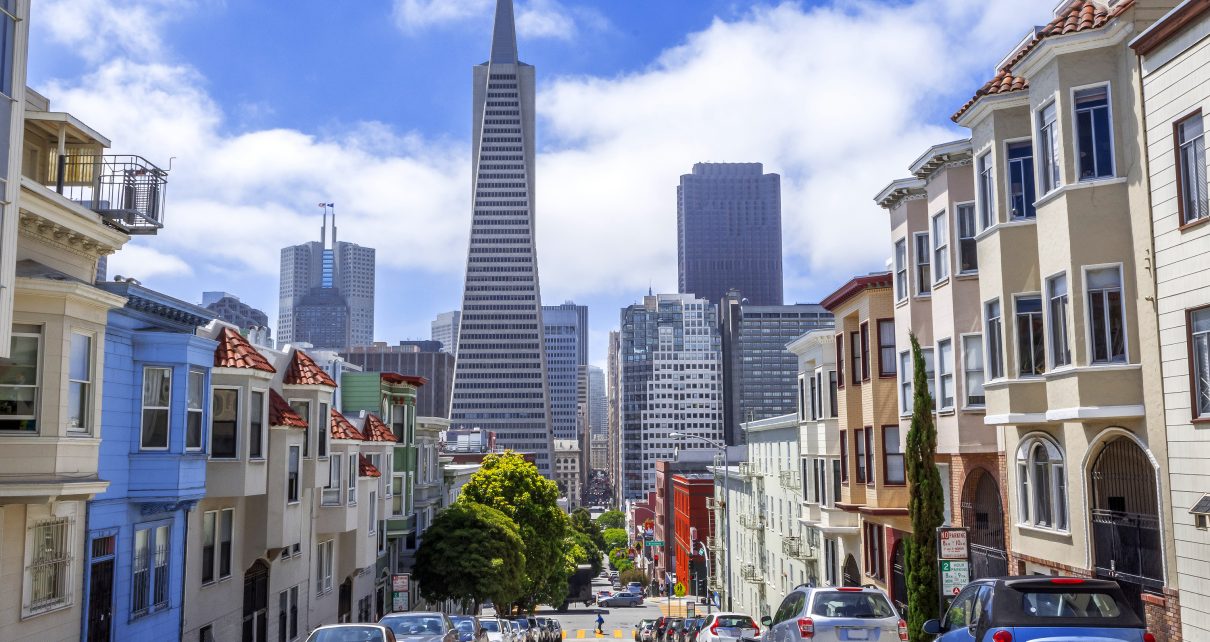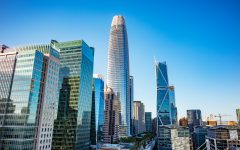
Montgomery St. and Skyline of Downtown areas of San Francisco, CA. (Photo: Randy Andy/ Shutterstock)
San Francisco Office Vacancy Rates Reach Record High of 35.9%
Prior to COVID-19 pandemic, San Francisco had a near 100% office occupation rate
By Evan Symon, December 19, 2023 2:30 am
According to a new report by real estate CBRE, the office vacancy rate of San Francisco hit a new high of 35.9% for the fourth quarter of 2023, shooting up nearly a full percentage point from the previous high of 35% from earlier this month.
Before the COVID-19 pandemic, San Francisco had a near 100% office occupation rate throughout the city, thanks in large part to the continuing tech boom and a steady demand for office space. However, with the COVID-19 pandemic, many companies began breaking leases to save money, while others embraced stay-at-home work and declined to continue using office space. Even after restrictions were dropped in 2021 and 2022, more companies switched to a work-from-home model or allowed more work-from-home positions, keeping many companies from returning to offices. In addition, high crime rates as well as a growing number of lease expirations by non-returning companies helped keep vacancy rates well above 20%.
In 2022 however, another major factor spiked vacancy rates yet again. Mass layoffs in the tech industry, which began in earnest in October 2022, quickly wiped out the need for large office complexes and long-term leases. Fueled by economic uncertainty, high inflation, rising insurance costs, more people working from home, the rise of AI and automation, the continued rise of e-commerce, the rising crime rate in San Francisco, and many companies overcompensating, many large companies shed thousands of employees overnight. Tens of thousands of cuts came from longtime Silicon Valley stalwarts Google, Amazon, Intel, Lyft, Yahoo, Meta and Salesforce, with the second quarter of 2023 even producing many corporate, non-tech layoffs for companies in the city as well.
As a result, the average office vacancy rate in San Francisco jumped from 19% in 2021 to 27% in 2022 to 29.4% in the first quarter of 2023 to 31.8% in June. There was some good news during this time, with AI companies rushing into the city through a new tech field boom. In some cases, companies swooped in and leased 500,000 square feet of office space at once. However, that failed to break many trends. By September, the vacancy rate was at 33.9%, with crime forcing some tenants to switch to remote work and large scale renter companies such as WeWork also failing. By the end of November, that figure had risen to 35%.
Reaching a new vacancy record
However, the overall decline continued through December, reaching 35.9% this month. While more AI firms have set up shop in San Francisco, along with many companies electing to keep offices through the holidays, many companies continued to leave or shored up office space to save on high real estate costs in the city. In total, as of mid-December, 31.5 million square feet of office space remains vacant throughout San Francisco.
While much of the new vacant space is attributed to many companies and firms either not renewing leases or leaving, a large proportion is also because of large sub-leases going unfilled. Experts noted on Monday that while vacancy rate has been slowing down, it is expected to go down well into 2024 and possibly reaching 40% before going back up.
“Occupancy losses will continue through the first half of 2024, driving up overall vacancy even further, before stabilizing in the second half of next year as economic conditions improve and interest rates decline,” said CBRE executive Director Colin Yasukochi.
Building occupancy researcher Michelle Duggan added that “AI is really helping out, but San Francisco itself is not really giving any incentive for companies to move in. It is still a tech heavy city, and wanting to be around those companies is keeping that up. And a bunch of smaller tenants, like, say, law firms or small start-ups, they can take little pieces here and there. But they need big companies coming in. That’s hard to do with a reputation that a city like San Francisco currently has, not to mention taxes and ease of travel and so many other factors.
“But 35.9%. LA is at 15.5%, only up from 14.2% earlier this year, with a turnaround expected soon. San Jose is at 31.5%, but only up from 31.3%. And look outside California. Chicago is at 23.7%. New York around 17%. Austin 22%. Miami is at LA levels. It is everywhere to some extent because of so many working from home or utilizing less space. But San Francisco and San Jose and any tech heavy city, even to areas where companies from California are moving too, have these higher vacancy rates. More diversified cities that didn’t put all their eggs in one basket, they have much less a problem with vacancies and have found ways to keep tenants in.
“And look, San Francisco is still chasing tech with AI. They need to diversify, maybe try to attract banking back. Something. But, at this point, that is going to be hard to do.”
The first vacancy figures for 2024 are expected to come out early next year.
- Bill to Require Law Enforcement Disclosure if AI Was Used To Help Write Reports - August 7, 2025
- Gov. Newsom Files FOIA Request To ‘Expose True Cost’ Of L.A. Federal Troop Deployment for Anti-ICE Riots - August 6, 2025
- California Redistricting: How Newsom’s Plan Will Demolish Hard Fought GOP Gains - August 6, 2025





While SF continues to collapse, Democrat Mayor London Breed and the Democrat controlled Board of Supervisors try to deflect their failures by focusing on reparations. Democrats have controlled San Francisco for most of the city’s history so if any group should be paying reparations, it’s members of the Democrat party. Democrats are the party of slavery, segregation, Jim Crow laws and the KKK. Maybe it’s time SF Democrats pay for the sins of their Democrat predecessors?
Fifty years ago San Francisco was the most desirable city in the United States in which to live and work. The streets were clean and the walk from the Ferry building to Montgomery Street was a pleasant experience. Lunch time usually included a walk to a nearby restaurant, greeting friends on the clean sidewalks along the way. An after work stop for a drink with friends and associates and then walk to transportation was pleasant and safe.
The vision that massive office buildings will be converted to residential uses is a wonderful vision that’s not really been tested against the the functional, financial and social challenges.
– A change in use requires that the building be brought up to current code requirements including structural
-The conversion process essentially only uses the building’s structure, elevators, a portion of the exterior and portions of the plumbing and electrical systems.
– Many of the large buildings have a significantly greater challenge as the core to window distances do not work well for residential uses.
– The costs to operate large buildings are significant. One small example is security .
-Many of the buildings lack adequate onsite parking and the streets are only marginally safe during the day.
– The lack of quality public schools for the children of residents
– Unsafe streets
The most important, foundational change needed is to restore law and order in the streets including removal of the encamped army of addicts and gang members.
Can this be done,,,,,, Yes Rudi proved that NY could be rescued with relatively simple steps . If done the office buildings will not need to be abandoned or converted. To accomplish this the City’s voters will need to empower leaders who understand the mission and whose objectives are to make the city great again and safe for all residents and visitors